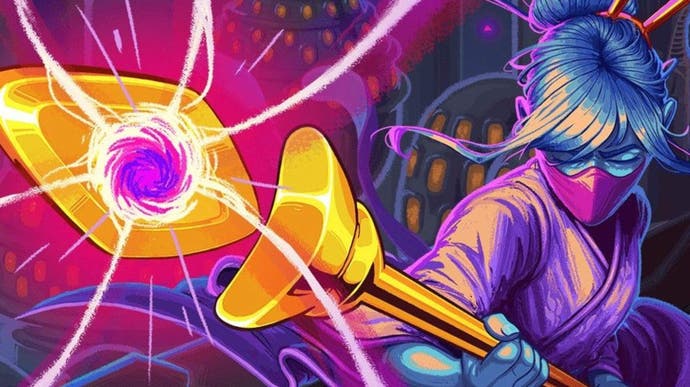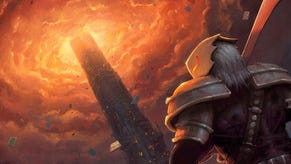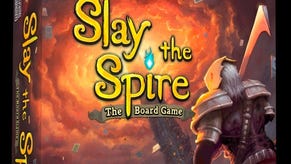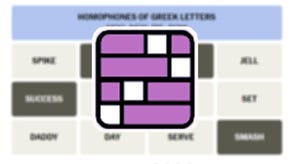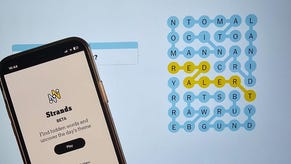Slay the Spire The Watcher explained: How to unlock, best Watcher builds and card recommendations
Keep Calm.
The Watcher is Slay the Spire's fourth character, a blind ascetic - a kind of monk - who has come to evaluate the Spire.
What makes her so different from the other classes is her ability to move in and out of powerful stances using cards.
This page explains how to unlock The Watcher, and gives our best Watcher build suggestions and some cards to look out for.
Make sure you also check out our essential tips for getting better at Slay the Spire.
On this page:
How to play as The Watcher in Slay the Spire
The Watcher has three stances - Calm, Wrath and Divinity.
Calm doesn't do anything inherently but when you move out of it, you get two extra Energy to spend. Wrath, meanwhile, grants you double-damage but has you receive double-damage too. The general rule of thumb is to move from Calm into Wrath, gaining extra Energy to use on your assault. Try dropping into Calm the round before you want to unleash.
Divinity is an ability for a special occasion. It's activated by accruing 10 Mantra from various cards, and it grants you three extra Energy and triple-damage for one round. It's very powerful but you will use Calm and Wrath more frequently.

The Watcher, then, is about planning ahead to unleash a deadly assault. But plan well. Try not to accidentally strand yourself in Wrath at the end of a round and leave yourself open to taking double-damage, unless it's all part of the plan. Keep a stance-cancelling or stance-changing card handy.
Key effects for the Watcher are Miracles, Retain and Scry. Miracles are free Energy and Retainable so you can use them whenever you want. Retain does as it sounds: allows you to hold onto cards between rounds, and some of the cards you Retain get stronger the longer you hold them. Scry, meanwhile, lets you look through and manipulate your Draw pile, and knowing which cards you'll draw next is very useful.
How to unlock The Watcher in Slay the Spire
The Watcher is not unlocked by default. To unlock it, you need to have a successful run with one of the other characters and defeat the Act 3 boss. You also need to already have the Silent and Defect classes unlocked. Doing this is simple. Play as the Ironclad once to unlock the Silent, and play as the Silent once to unlock the Defect.
The best Watcher deck build recommendations in Slay the Spire
You never know which cards you'll get while you play so always be flexible with builds. Relics might alter your approach too, depending on what you get, but there are a few deck themes to have in mind as you build.
Remember, keep your deck small. You don't need to take every card offered to you - you can skip card rewards. It's better to build around one idea and keep it thin and focused than bloat your deck. Bigger decks mean a lower percentage chance to draw the cards you want, when you want them. Think about what fits your deck and ignore the rest, and remember cards rewards will get better the further you get.
A good deck size is 15, which, given you begin with 10 cards, means you will want to replace some of those you begin with - namely your default Strike and Defend cards. There are simply better one-cost cards. Your Defend cards can go first because your Strike cards can still be useful when you're in Wrath mode dealing double damage.
You can replace cards using the merchant's Card Removal Service or when in some special events denoted by question marks on your map.
Also remember to upgrade your cards. The difference between an average card and a great card can be one simple upgrade. An invaluable card to help with this is Lesson Learned, which deals damage and if fatal, it permanently upgrades another random card in your deck.
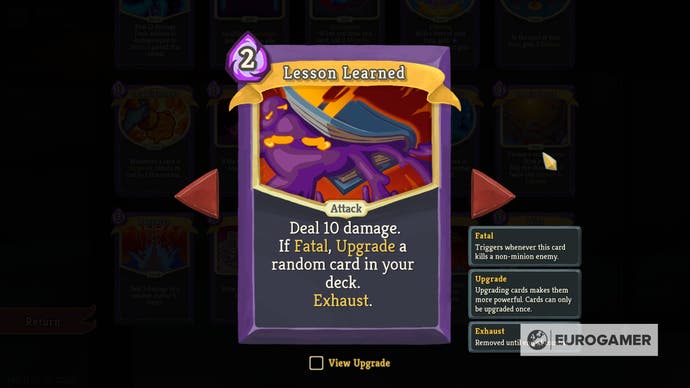
Retain
A Retain deck is built around steadily accruing the cards you need for a devastating attack round. Keep an eye out for these attack cards: Windmill Strike, Battle Hymn, Sands of Time and Reach Heaven.
Windmill Strike gains damage each round it's Retained; Sands of Time is a big hitter which gets cheaper each round it's retained; Battle Hymn gives you a Retainable Smite card every turn; and Reach Heaven does damage and gives you a powerful Through Violence card you can Retain.
You'll need some defence while you build up. There are various options - Protect and Perseverance are Retainable and the latter gains more block the longer it's held - but a better option is Spirit Shield, which gives a small amount of block for each card in your hand, and the chances are you'll hold a lot.
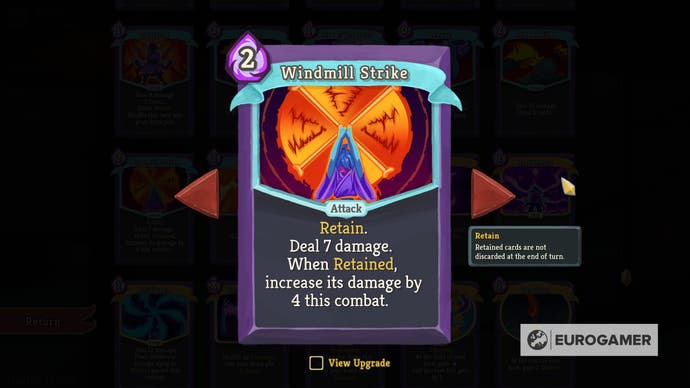
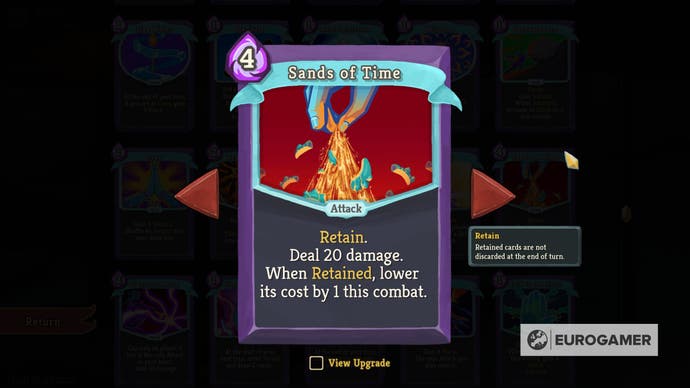
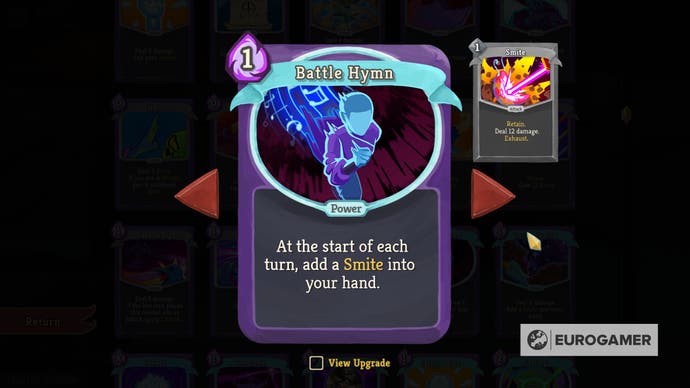
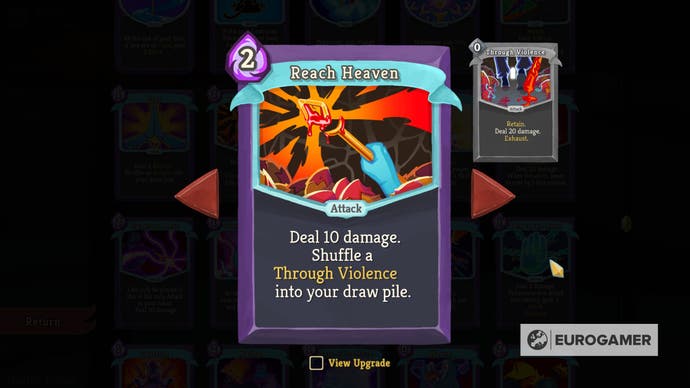
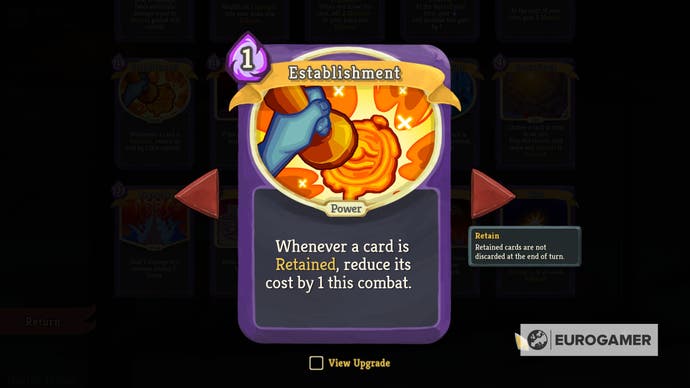
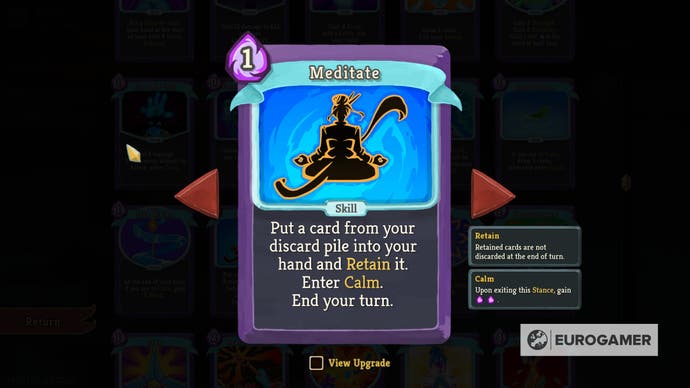
Make sure you've got a reliable way of getting from Calm into Wrath. Crescendo is a Retainable Wrath maker, and Tranquility a Retainable Calm maker. You could even Retain Blasphemy for Divinity if you're feeling lucky, but remember it will kill you next turn so you'd better get your maths right.
Finally, consider Establishment, a card which makes any Retainable card cost one less Energy each round it is held. And if you mix Meditate in, it will help you redraw cards and add Retain to cards which otherwise don't have them. But beware: using Meditate ends your current turn.
Pressure Points
Pressure Points is a curious card. It does two things when you play it: it applies a Mark debuff and causes damage equal to it. The Mark debuff then remains so if you play Pressure Points on the same enemy again, they'll have a double stack of Mark and take damage equal to the total. This can add up to incredible amounts of damage.
Furthermore, Mark can be applied to multiple enemies. You can alternate who you play Pressure Points on and each time you play it, anyone with Mark will take damage equal to it, making it a nifty form of crowd control.
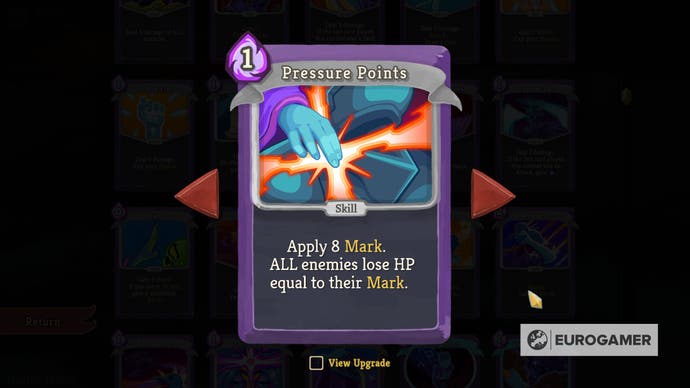
But to make a Pressure Points deck work, you really have to lean into it, adding multiple copies - at least three - to your deck, and keeping your deck very small.
Remember, Wrath won't affect Pressure Points so don't bother using it, and ditch those Strike cards. Look for Calm-related abilities instead, such as Like Water, which gives you free block each round and can be stacked. It combines well with Wave of the Hand to weaken enemies too.
Stance Dance
Moving in and out of stances feels pure Watcher, and there are numerous cards which combine to great effect.
Make sure, to begin with, you have enough cards to get in and out of Calm and Wrath. Empty Body is always useful as it cancels your stance while giving you a decent amount of block. Empty Fist is very similar only it does damage and then cancels your stance, so use it in Wrath.
Cards which combine well include Flurry of Blows, a zero-cost damage card which reappears every time you change stance; Rushdown, a card which grants two extra cards every time you enter Wrath, and Mental Fortress, which gives block each time you change stance. Halt is good here too, but use it in Wrath to get maximum block before changing stance. The same could be said for Wallop, which gives you as much block as you do unblocked damage.
Mantra
Other deck themes include building around Mantra to trigger Divinity, and holding onto a powerful attack like Signature Move or Conjure Blade to use when you get there. Conjure Blade makes a powerful sword which swings as many times as you spend Energy on it. If you save your upgraded Miracle cards from Collect for it, and they're Retainable so you can, you could conjure a sword with several swings. And remember you will be swinging for triple damage.

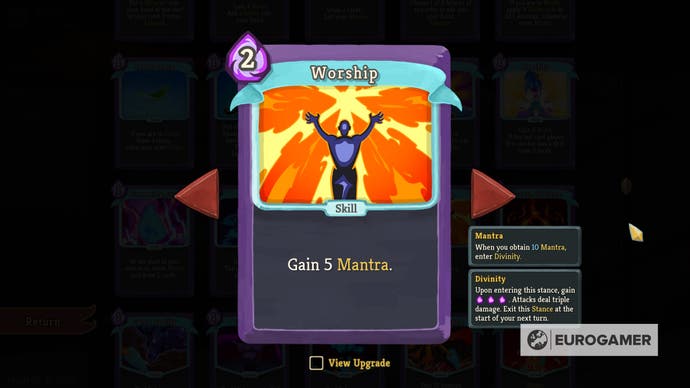
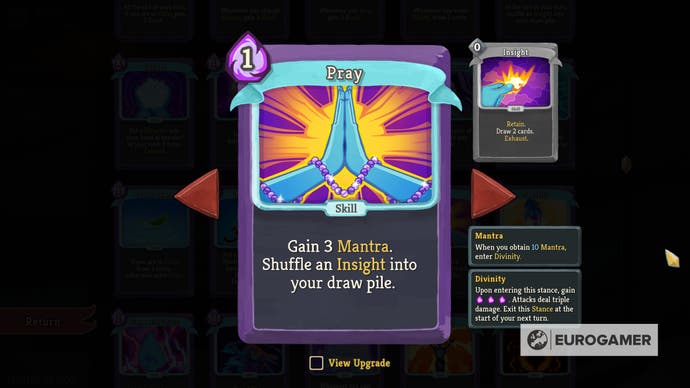



Best The Watcher cards to look out for in Slay the Spire
This list is by no means exhaustive, and may indispensable cards have already been mentioned, particularly Lesson Learned, but here are some other cards to keep an eye out for.
- Cut Through Fate - A common card with superb utility. It deals good damage and lets you draw one of two cards, or a random one, from your Draw pile
- Scrawl - This card completely refills your hand. Go bananas in Divinity and then burn all your Miracles and hit Scrawl to have another go.
- Vault - A card which grants you another turn. When upgraded, it only costs two Energy, which means you get a whole new hand, three energy and whatever start-of-turn and Retain buffs you've got going, all for two Energy.
- Crush Joints - A card which does decent damage and applies the Vulnerable debuff, as long as the last card you played was a skill. With the Vulnerable debuff active, and Wrath stance active, enemies will effectively be taking triple-damage from you. The only tricky part is getting Crush Joints to land on enemies with the Artifact buff, which negates debuffs. Try clearing the Artifact buff with Wave of the Hand.
- Third Eye - Don't overlook it. It gives you good block and lets you Scry three cards, and so sort out your draw pile. Combine Scry cards with Weave and Nirvana for a free attack and free extra block.
- Master Reality - Any time a card is created this combat, it will be upgraded, which works well with so many Watcher cards: Battle Hymn, Reach Heaven, Conjure Blade, Deceive Reality.
- Deceive Reality - A weaker block card which creates a stronger block card that you can Retain. Very useful.
- Sanctity - A one-cost card which gives you block and draws two cards, so long as you last used a skill. Remember, Miracles are skills so they are good set-ups for this.
- Alpha - The beginning of a chain which will eventually unleash a devastating attack which damages all enemies, but it requires playing Alpha, Beta, and then the damage card itself, Omega.
Want some extra pointers for the rest of the game? See our essential tips for getting better at Slay the Spire.
